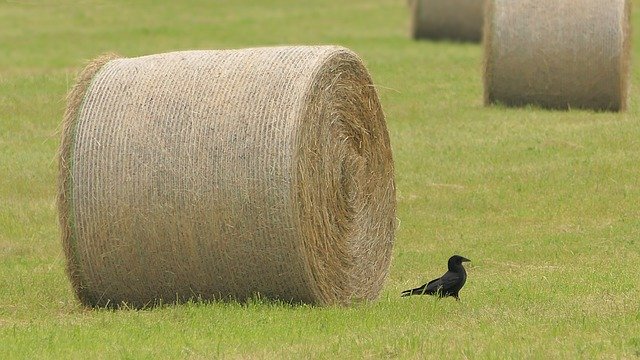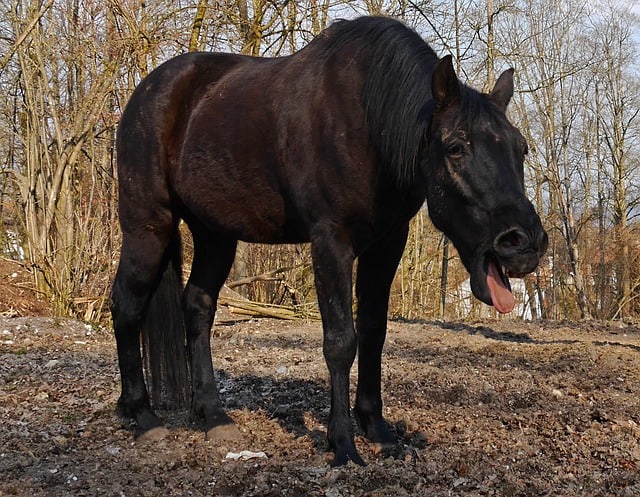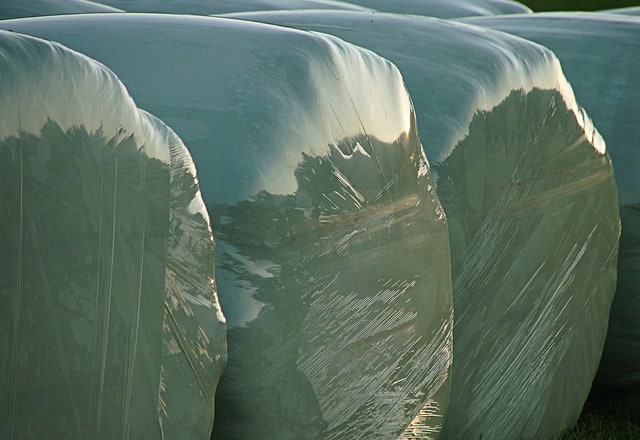At this time of the year horse owners and producers are already thinking about the next seasons forage. Inevitably we will be asked on numerous occasions about our advice in relation to hay versus haylage. The first comment has to be that you can get excellent hay and excellent haylage. You can also get extremely poor hay and extremely poor haylage. The obvious difference is that you can get a good idea about hay quality prior to purchase, whereas with haylage you often have to wait until you open that plastic to know your faith.

Horse diets should be based on forage (1.5-3% body weight daily) and owners will have a choice between providing hay or haylage depending on the weather at the main harvest times. The decision to feed a particular forage is often based on availability, cost, and storage facilities.
Some horse owners prefer to feed haylage because they believe this product is a better source of digestible energy and protein. Without analysing each batch of forage, it is impossible to know exactly what the nutrient profile is.
At the Irish Equine centre we analyse thousands of hay and haylage samples every year for both hygiene (mould and bacteria levels) and for nutritional content. The reality is that we get hay and haylage with extremely good nutritional and hygiene values, we also get hay and haylage with very poor nutritional and hygiene values.
From a sampling point of view it is much easier to get a representative sample from a batch of hay than it is from haylage as you can take a small sample from multiple bales of hay easily whereas it is not so easy with wrapped haylage.
“It is really important for horse owners to realise that constantly changing forage types is extremely detrimental to horse health and is often responsible for gastric problems and colic.”
A.Creighton.
It is really important for horse owners to realise that constantly changing forage types is extremely detrimental to horse health and is often responsible for gastric problems and colic. Ideally you should produce or purchase enough of the same batch of quality forage for the whole season.
It is our experience from testing forage that getting haylage with consistent nutritional values is very difficult. This is mainly due to the variants in moisture content. Hay which is well made and stored does tend to be much more consistent and therefore better for overall horse health.
Haylage has a lower dry mater content of 30-65% compared to hay, 80-90%. Haylage has a much higher moisture content than hay which therefore means that more haylage is required to be fed as compared to hay, to meet the daily recommended guidelines for dry matter intake.
The Irish Equine Centre recommends to use haylage within 4 days of opening a bale in the winter and 3 days in the summer.
The Irish Equine Centre
Haylage can contain higher crude protein, fat and digestible energy. When feeding haylage, the fermentation process can begin quickly if the bale is exposed to air; this may be due to damage of the wrapping or not using the bale quick enough once opened. Mould spores or fungi will develop and this should be carefully assessed before feeding to your horse. This is a major problem we encounter on a regular basis. Often horse owners are feeding big bales of haylage to a small number of horses which means the bales are exposed to air for a prolonged period of time. Pathogenic mould will develop very quickly and often lead to both respiratory and gastric problems. For that reason the IEC will recommend to use haylage inside of 4 days in the winter and 3 days in the summer.
This recommendation will often determine the choice between hay and haylage as you would therefore need to be feeding a larger number of horses to feed haylage as the small bales are a lot more expensive.

Hay
Hay can contribute to respiratory issues from the dust, mould spores and fibrous plant material, known as the respiratory dust concentration of the hay. If these are high they can result in airway irritation, not ideal for performance horses or those suffering from respiratory conditions such as COPD (chronic obstructive pulmonary disease) or EIPH (bleeding).
The quality of the hay crop is dependent on two main factors;
- The weather and
- The manufacturer or producer.
In general the quality of hay production in this country has improved over the last number of years due to machinery upgrades and updated knowledge of drying and preservation.
The most obvious difference between hay and haylage, is the way in which it is made. Hay is usually cut between the months of May to August, weather permitting. It is cut, left to dry on the ground and then turned in order to ensure it is sufficiently dried. Hay is often ‘turned’ many times to ensure that the moisture levels are reduced to between fifteen and twenty percent.
Good Quality Hay always has a very low moisture content. This reduced moisture level, ensures that the risk of any Mould is kept to a minimum.
A. Creighton
Ensuring that hay is sufficiently dried is it’s preservation method. Reducing the moisture level to such a low point ensures that the risk of mould development during storage is kept to a minimum. Reducing the moisture of hay to a low enough level and keeping it at that level is the key to hay quality.
The storage of hay in Ireland and the UK is often the main issue in terms of hygiene quality of hay. Storage of hay has become difficult since the advent of larger round or rectangular bales. These larger bales are difficult to dry out sufficiently, as the moisture at the centre of the bale is difficult to remove. The storage is also difficult as we tend to have long periods of high humidity from late autumn to late spring. When we have this high humidity or dampness, dry bales will act like a sponge and take moisture back in. We will then see moulding on the outside of these bales in times of mild weather.
Our advice is to cover hay in late autumn with straw or plastic once the threat of heating has passed. When hay is dried and then covered properly it tends to stay consistent for extremely long periods of time ensuring consistent forage for your horse
Haylage.
Haylage is cut like hay, but only allowed to semi-wilt and not dry as much as hay. It is usually cut later than silage, but earlier than hay. Haylage is often baled between twenty four and forty eight hours of being cut or when the levels of moisture are only reduced to around forty to fifty percent. The bales are then compressed and wrapped in multiple layers of plastic. This eliminates oxygen reaching it and creates the anaerobic conditions needed for desirable fermentation of the haylage to occur.
This ‘desirable fermentation’ is necessary to allow bacterial species such as lactobacilli which are naturally present in the crop to utilise water soluble carbohydrates to survive and produce lactic acid. The production of lactic acid is important as this is what causes the pH to drop to a level between 4.8 and 5.8. This drop in pH inhibits the growth of undesirable mould.

The Main Difference Between Feeding Hay or Haylage.
The main difference in terms of nutrition between the two types of forage is the way in which the leaf structure is preserved. In the case of hay making, the drying process leads to leaf fracture, a problem which can create dust and loss of the nutrients present in the grass. These include water soluble carbohydrates, protein, vitamins and minerals.
Haylage typically can have a higher feed value than hay due to the decreased level of drying involved in haylage production.
A. Creighton
Haylage typically can have a higher feed value than hay due to the decreased level of drying involved in haylage production. Assuming the product is made correctly, haylage will typically provide higher levels of digestible fibre, energy and protein because these components are better preserved through minimised leaf fragmentation. Haylage made specifically for the equine market is often produced from specially grown grasses (Timothy and rye grass), which have a higher feed value than meadow grass. For racehorses this higher feed values are not always ideal as the variability and often higher protein levels in haylage can cause muscle problems.
When feeding hay, the horse spends a lot more time chewing, consequently this aids in the production of Saliva. The saliva, helps to neutralise excess stomach acid, which will help in the prevention of ulcers.
A. Creighton
The digestive system of the horse is designed to graze constantly. Digestive disorders such as stomach ulcers increase when we move too far away from constant grazing. Horses are designed to have a regular intake of roughage. Since the horse’s stomach continually secretes acid, gastric ulcers can result when the horse is not eating regularly.
Saliva in the mouth contains bicarbonate which buffers (neutralises) acidity in the gut. More chewing produces more saliva, and the chew time with hay is a lot longer than with haylage. The horse therefore produces a lot more saliva when fed hay as compared to haylage. Horses also tend to eat haylage quicker which often leads to longer periods with no roughage in the stomach.
The Benefits of Hay:
- Good quality hay, will provide horses and ponies in light work, or who are ‘good doers’ with the sufficient amount of forage needed for energy. In this respect it is also good for feeding ‘ad-lib’. With its lower energy value, enough can be fed to provide the horse with sufficient forage, without concern about unwanted weight gain associated with feeding haylage.
- Hay of good quality will also remain in good condition for a longer period of time if stored correctly in a dry environment. A good batch of hay will provide consistent roughage for your horse for the season.
- Hay can be significantly cheaper to buy than haylage as the dry matter is a lot higher.
- You can inspect a batch hay properly prior to purchase. This means you can be confident that you can take a representative sample for the testing lab which can then be the deciding factor for your purchase.
- Horses chew and eat hay for longer than they do haylage and therefore can reduce the incidence of digestive disorders.
The downsides to Hay:
- Poorly produced hay can contain dust and mould spores, which can be in a greater quantity than moist haylage. This combined with its lower moisture content means these can become airborne and are a health risk to horses who are stabled frequently or have existing respiratory problems such as COPD.
- Large round and rectangular bales of hay can be difficult to dry and store in Ireland and the UK due to our temperate climate.
- To store hay properly you need adequate indoor buildings.
The benefits of Haylage:
- Due to the manufacturing process, grass used for haylage tends to be younger and so is more digestible to horses meaning they tend to ‘do better’ on it because it provides higher levels of digestible fibre, energy and protein.
- Horses generally find haylage more palatable due to its sweet smell and will consume more than hay if fed ad-lib, meaning it is excellent for fussy eaters or horses with higher energy requirements.
- Whilst haylage is more expensive to buy than hay it can be better value if the quality is good, as less concentrate food needs to be fed because of its higher energy level.
- Correctly made haylage contains very few if any, mould spores, and because of its higher moisture content any which are present do not become airborne and, therefore, do not cause problems.
- Haylage can be stored outside and therefore negates the need for storage sheds.
The downsides to haylage:
- Haylage will start to deteriorate quickly once opened and should be used within 4 days in the winter and 3 days in the summer, meaning it is not practical or economical for owners with smaller numbers of horses.
- Haylage can provide horses prone to weight gain or laminitis with an excess of energy provided by their forage. People cutting down the amount fed to reduce unwanted weight gain risk their horses having insufficient forage, which can lead to an increased risk of stomach ulcers and other digestive problems.
- You can’t visibly inspect every bale prior to purchase. It is also difficult to take a representative sample as a supplier will not want to open numerous bales for testing. This can lead to nasty surprises when you do open each bale.
- The nutritional values of haylage can be very varied from bale to bale, even from the same field. This variability is not good for the digestive system of the horse.
Conclusion
To conclude the advice to horse owners should always be to acquire the best possible forage available and test it prior to purchase. Good quality tested hay is the most beneficial to horses when all factors are taken in to account.
Once purchased hay should be stored properly to ensure that it remains consistent. Horse owners with inadequate storage may have no choice, other than to feed haylage. If this is the case buy the right size of bales for the amount of horses you are feeding.
The nutrition department at the Irish Equine Centre provide full nutritional and hygiene testing for hay and haylage. It is vital that you test forage pre-purchase when trying to buy a year’s supply for your horses. The staff in this department are always available for advice, so do not hesitate to call or email if you have any questions.
Alan Creighton is the Head of Environment & Nutrition at the Irish Equine Centre. You can contact the IEC through their website www.irishequinecentre.ie .
This Article was originally published in the May 2019 Issue of Irish Sport Horse Magazine.
